- Calendar
- Online Ticket Sales
- Access
- JA
- EN
Imari: Japanese Porcelain for European Palaces
January 25 to March 16 2014
Chapter 1
IMARI Launched Out to the World, 1660-1670s
As the Chinese Qing administration banned maritime activities with overseas countries due to the civil war during the change of government from the Ming to Qing, the amount of Jingdezhen porcelain exported overseas dropped dramatically. Searching for a replacement, the Dutch East India Company drew their attention to the porcelain of Arita in Kyushu, Japan. The potters of Arita, demonstrating remarkable innovation of their workmanship by adopting the production techniques of China, accepted strict quality standard requirements by the Dutch and improved their skills even further, producing wares of exquisite quality that could even beat that of their Jingdezhen counterpart.
Many Imari export wares at that time were vessels modeled on Jingdezhen blue-and-white porcelain as well as practical tableware and drinking vessels adopting the forms of European ceramic vessels. A relatively large proportion of blue-and-white ware was also observed. The ware that deserves special mention is the copy of a dish known as fuyode, which was produced in Jingdezhen at the end of the Ming dynasty and exported to Europe in massive quantities. Dishes with identical designs were produced in different sizes. Part of the top-quality wares for the domestic market was also exported during this time, probably because the made-to-order production was unable to keep up with the high demand.
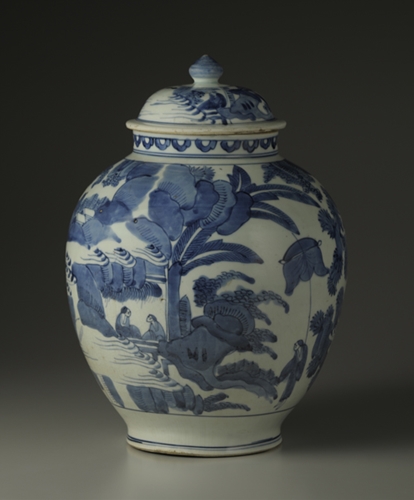
JAR/Blue-and-white with design of landscape and human figures
Arita ware
Edo period, 1655-1670s
The Museum of Oriental Ceramics, Osaka
Photo by Kazuyoshi Miyoshi
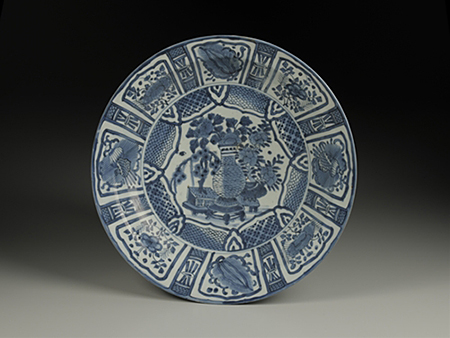
DISH/Blue-and-white, Kraak style (fuyode) with flower arrangement design
Arita ware
Edo period, 1660–1670s
The Museum of Oriental Ceramics, Osaka
Chapter 2
IMARI – The Ware of Enchantment, 1670-1690s
Exportation of Imari ware to Europe reached its peak during this period. One of the important wares to be mentioned is the porcelain with overglaze enamels produced at the Kakiemon kiln around the 1670s, which has a warm, creamy white body (known as nigoshide) and afine,molded form onto which a polychrome enamel decoration was delicately painted. This is what is known today as “Kakiemon-style” ware. This elegant ware, boosted by the fashion of orientalism, enchanted the kings and nobility of Europe and later inspired the factories such asMeissen in Germany, Sèvres in France and Chelsea in England to produce imitations.
The trade restriction imposed by the government in 1685 led the majority of exportation of porcelain to shift to private trade in which the trade valuewas fixed. The government also lifted the tariff based on volume, which resulted in the increase of large-size products to be exported. It was around this timewhen the set of five large vessels comprising jars and vases for decorating the interior of the European palaces became a fashion.
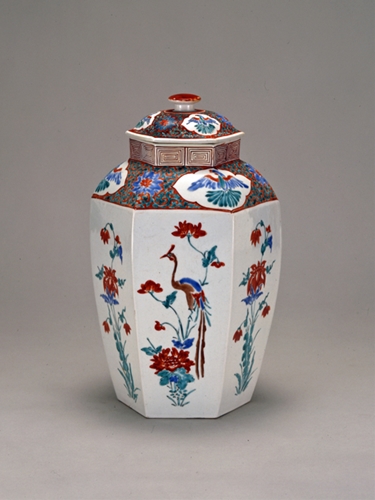
HEXAGONAL JAR/Porcelain with flower-and-bird design in overglaze polychrome enamels
Arita ware
Edo period, latter half of the 17th century
Suntory Museum of Art
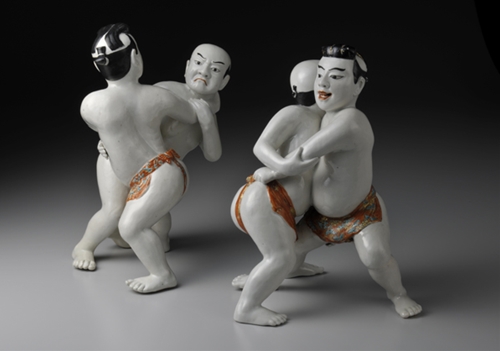
FIGURINES OF SUMO WRESTLERS (two sets)/Porcelain with decoration in overglaze polychrome enamels
Arita ware
Edo period, 1680–1710s
The Museum of Oriental Ceramics, Osaka
Chapter 3
A Dazzling Charm for the European Nobles, 1690-1730s
The Kakiemon-style porcelain with overglaze polychrome enamels exported since the 1670s, which held sway over the minds of the European nobles,was short-lived, however, and disappeared by the 1690s. It was replaced by the “kinrande-style” ware, known for the lavish decoration of gilt and polychrome enamels. Modeled on the wares with gilt decorations popularly made during the Jiajing (1577-1566) and Wanli (1573-1620) periods of the Ming dynasty, the kinrande-style wares were basically decorated in underglaze blue onto which gilt and iron-red paint were applied and fired at a low temperature. More colorful wares were also made by adding enamels such as green, yellow and purple.Orders of large jars and vases for decorating the interior of the European palaces and mansions, some of which measure over 90 centimeters in height, increased in numbers. It was around this time that August the Strong, Elector of Sachsen and one of the prominent collectors of oriental ceramics and later the founder of the Meissen manufactory, ardently collected Imari ware.
In 1684, when the ban on maritime activities in Qing China was lifted and Chinese porcelain including Jingdezhen ware once again began to be exported overseas, Imari ware was compelled to face a fierce competition with the Chinese porcelain to survive in the European market. The style of Imari ware, which had already been enjoying a certain degree of recognition, was often imitated by the Jingdezhen ware, known as “Chinese Imari”.
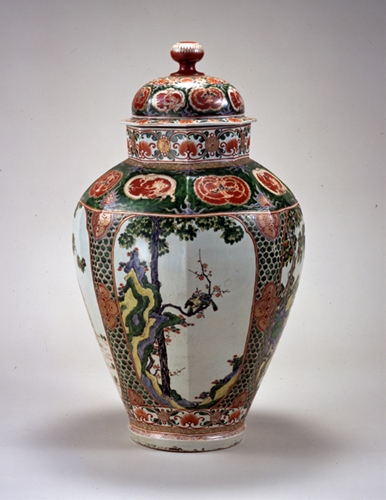
Important Cultural Property
LARGE OCTAGONAL JAR/Porcelain with flower-and-bird design in overglaze polychrome enamels
Arita ware
Edo period, 1680–1710s
Suntory Museum of Art
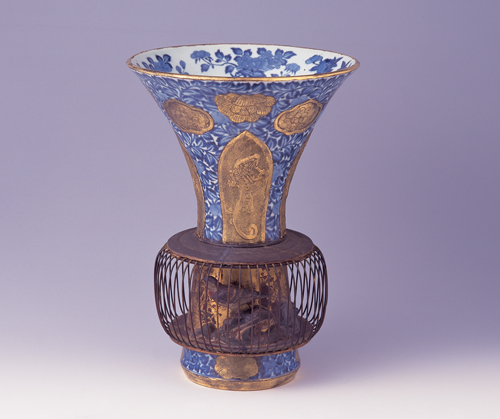
LARGE TRUMPET-MOUTHED VASE/Blue-and-white with applied maki-e (lacquer sprinkled with gold powder) decoration and a birdcage
Arita ware
Edo period, 1690–1730s
The Kyushu Ceramic Museum
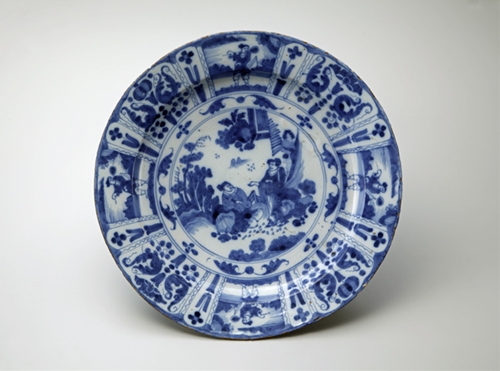
Delft ware, the Netherlands
Latter half of the 17th century
Suntory Museum of Art, gift of Mr.Toshiyuki Noyori
Chapter 4
The End of the Era of Exportation, 1730-1750s
Since 1684, the rivalry with the Jingdezhen porcelain over the European market drew to a close with Imari ware eventually being replaced with Jingdezhen ware. Moreover, the fact that the Dutch who were handling the exportation of Imari warewere defeated by England in Asian trade, as well as that porcelain production in Europe including Meissen developed in various regions also contributed substantially to the decline of Imari ware in the European market.
After the death of August the Strong, elector of Sachsen and an avid collector of Imari in 1733, the popularity of Imari ware gradually waned. The last bloom of Imari export ware was during the era of Maria Theresa (r. 1740-1780), the empress of the Habsburg Empire, when a few distinctive Imari ware was observed in Europe. In 1757, official exportation of Imari ware to Europe came to an end, while the Dutch East India Company, which played the leading role in exporting Imari ware, disbanded in 1799.
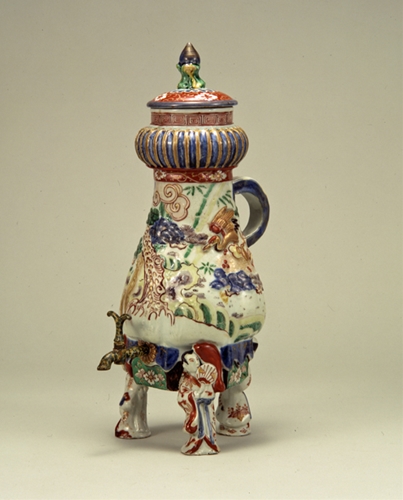
Arita ware
Edo period, 1730-1750s
Suntory Museum of Art
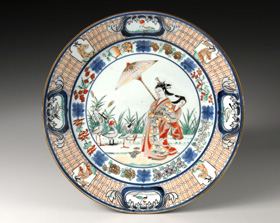
Arita ware
Edo period, 1730-1740s
The Museum of Oriental Ceramics, Osaka
*Unauthorized reproduction or use of texts or images from this site is prohibited.
2024 January
- Exhibition
- Closed
- Tea Ceremony
- Mon
- Tue
- Wed
- Thu
- Fri
- Sat
- Sun
- 1
- 2
- 3
- 4
- 5
- 6
- 7
- 8
- 9
- 10
- 11
- 12
- 13
- 14
- 15
- 16
- 17
- 18
- 19
- 20
- 21
- 22
- 23
- 24
- 25
- 26
- 27
- 28
- 29
- 30
- 31
2024 February
- Exhibition
- Closed
- Tea Ceremony
- Mon
- Tue
- Wed
- Thu
- Fri
- Sat
- Sun
- 1
- 2
- 3
- 4
- 5
- 6
- 7
- 8
- 9
- 10
- 11
- 12
- 13
- 14
- 15
- 16
- 17
- 18
- 19
- 20
- 21
- 22
- 23
- 24
- 25
- 26
- 27
- 28
- 29
2024 March
- Exhibition
- Closed
- Tea Ceremony
- Mon
- Tue
- Wed
- Thu
- Fri
- Sat
- Sun
- 1
- 2
- 3
- 4
- 5
- 6
- 7
- 8
- 9
- 10
- 11
- 12
- 13
- 14
- 15
- 16
- 17
- 18
- 19
- 20
- 21
- 22
- 23
- 24
- 25
- 26
- 27
- 28
- 29
- 30
- 31
2024 April
- Exhibition
- Closed
- Tea Ceremony
- Mon
- Tue
- Wed
- Thu
- Fri
- Sat
- Sun
- 1
- 2
- 3
- 4
- 5
- 6
- 7
- 8
- 9
- 10
- 11
- 12
- 13
- 14
- 15
- 16
- 17
- 18
- 19
- 20
- 21
- 22
- 23
- 24
- 25
- 26
- 27
- 28
- 29
- 30
2024 May
- Exhibition
- Closed
- Tea Ceremony
- Mon
- Tue
- Wed
- Thu
- Fri
- Sat
- Sun
- 1
- 2
- 3
- 4
- 5
- 6
- 7
- 8
- 9
- 10
- 11
- 12
- 13
- 14
- 15
- 16
- 17
- 18
- 19
- 20
- 21
- 22
- 23
- 24
- 25
- 26
- 27
- 28
- 29
- 30
- 31
2024 June
- Exhibition
- Closed
- Tea Ceremony
- Mon
- Tue
- Wed
- Thu
- Fri
- Sat
- Sun
- 1
- 2
- 3
- 4
- 5
- 6
- 7
- 8
- 9
- 10
- 11
- 12
- 13
- 14
- 15
- 16
- 17
- 18
- 19
- 20
- 21
- 22
- 23
- 24
- 25
- 26
- 27
- 28
- 29
- 30
2024 July
- Exhibition
- Closed
- Tea Ceremony
- Mon
- Tue
- Wed
- Thu
- Fri
- Sat
- Sun
- 1
- 2
- 3
- 4
- 5
- 6
- 7
- 8
- 9
- 10
- 11
- 12
- 13
- 14
- 15
- 16
- 17
- 18
- 19
- 20
- 21
- 22
- 23
- 24
- 25
- 26
- 27
- 28
- 29
- 30
- 31
2024 August
- Exhibition
- Closed
- Tea Ceremony
- Mon
- Tue
- Wed
- Thu
- Fri
- Sat
- Sun
- 1
- 2
- 3
- 4
- 5
- 6
- 7
- 8
- 9
- 10
- 11
- 12
- 13
- 14
- 15
- 16
- 17
- 18
- 19
- 20
- 21
- 22
- 23
- 24
- 25
- 26
- 27
- 28
- 29
- 30
- 31
2024 September
- Exhibition
- Closed
- Tea Ceremony
- Mon
- Tue
- Wed
- Thu
- Fri
- Sat
- Sun
- 1
- 2
- 3
- 4
- 5
- 6
- 7
- 8
- 9
- 10
- 11
- 12
- 13
- 14
- 15
- 16
- 17
- 18
- 19
- 20
- 21
- 22
- 23
- 24
- 25
- 26
- 27
- 28
- 29
- 30
2024 October
- Exhibition
- Closed
- Tea Ceremony
- Mon
- Tue
- Wed
- Thu
- Fri
- Sat
- Sun
- 1
- 2
- 3
- 4
- 5
- 6
- 7
- 8
- 9
- 10
- 11
- 12
- 13
- 14
- 15
- 16
- 17
- 18
- 19
- 20
- 21
- 22
- 23
- 24
- 25
- 26
- 27
- 28
- 29
- 30
- 31
2024 November
- Exhibition
- Closed
- Tea Ceremony
- Mon
- Tue
- Wed
- Thu
- Fri
- Sat
- Sun
- 1
- 2
- 3
- 4
- 5
- 6
- 7
- 8
- 9
- 10
- 11
- 12
- 13
- 14
- 15
- 16
- 17
- 18
- 19
- 20
- 21
- 22
- 23
- 24
- 25
- 26
- 27
- 28
- 29
- 30
2024 December
- Exhibition
- Closed
- Tea Ceremony
- Mon
- Tue
- Wed
- Thu
- Fri
- Sat
- Sun
- 1
- 2
- 3
- 4
- 5
- 6
- 7
- 8
- 9
- 10
- 11
- 12
- 13
- 14
- 15
- 16
- 17
- 18
- 19
- 20
- 21
- 22
- 23
- 24
- 25
- 26
- 27
- 28
- 29
- 30
- 31
2025 January
- Exhibition
- Closed
- Tea Ceremony
- Mon
- Tue
- Wed
- Thu
- Fri
- Sat
- Sun
- 1
- 2
- 3
- 4
- 5
- 6
- 7
- 8
- 9
- 10
- 11
- 12
- 13
- 14
- 15
- 16
- 17
- 18
- 19
- 20
- 21
- 22
- 23
- 24
- 25
- 26
- 27
- 28
- 29
- 30
- 31
2025 February
- Exhibition
- Closed
- Tea Ceremony
- Mon
- Tue
- Wed
- Thu
- Fri
- Sat
- Sun
- 1
- 2
- 3
- 4
- 5
- 6
- 7
- 8
- 9
- 10
- 11
- 12
- 13
- 14
- 15
- 16
- 17
- 18
- 19
- 20
- 21
- 22
- 23
- 24
- 25
- 26
- 27
- 28
2025 March
- Exhibition
- Closed
- Tea Ceremony
- Mon
- Tue
- Wed
- Thu
- Fri
- Sat
- Sun
- 1
- 2
- 3
- 4
- 5
- 6
- 7
- 8
- 9
- 10
- 11
- 12
- 13
- 14
- 15
- 16
- 17
- 18
- 19
- 20
- 21
- 22
- 23
- 24
- 25
- 26
- 27
- 28
- 29
- 30
- 31
2025 April
- Exhibition
- Closed
- Tea Ceremony
- Mon
- Tue
- Wed
- Thu
- Fri
- Sat
- Sun
- 1
- 2
- 3
- 4
- 5
- 6
- 7
- 8
- 9
- 10
- 11
- 12
- 13
- 14
- 15
- 16
- 17
- 18
- 19
- 20
- 21
- 22
- 23
- 24
- 25
- 26
- 27
- 28
- 29
- 30
2025 May
- Exhibition
- Closed
- Tea Ceremony
- Mon
- Tue
- Wed
- Thu
- Fri
- Sat
- Sun
- 1
- 2
- 3
- 4
- 5
- 6
- 7
- 8
- 9
- 10
- 11
- 12
- 13
- 14
- 15
- 16
- 17
- 18
- 19
- 20
- 21
- 22
- 23
- 24
- 25
- 26
- 27
- 28
- 29
- 30
- 31
2025 June
- Exhibition
- Closed
- Tea Ceremony
- Mon
- Tue
- Wed
- Thu
- Fri
- Sat
- Sun
- 1
- 2
- 3
- 4
- 5
- 6
- 7
- 8
- 9
- 10
- 11
- 12
- 13
- 14
- 15
- 16
- 17
- 18
- 19
- 20
- 21
- 22
- 23
- 24
- 25
- 26
- 27
- 28
- 29
- 30
2025 July
- Exhibition
- Closed
- Tea Ceremony
- Mon
- Tue
- Wed
- Thu
- Fri
- Sat
- Sun
- 1
- 2
- 3
- 4
- 5
- 6
- 7
- 8
- 9
- 10
- 11
- 12
- 13
- 14
- 15
- 16
- 17
- 18
- 19
- 20
- 21
- 22
- 23
- 24
- 25
- 26
- 27
- 28
- 29
- 30
- 31
2025 August
- Exhibition
- Closed
- Tea Ceremony
- Mon
- Tue
- Wed
- Thu
- Fri
- Sat
- Sun
- 1
- 2
- 3
- 4
- 5
- 6
- 7
- 8
- 9
- 10
- 11
- 12
- 13
- 14
- 15
- 16
- 17
- 18
- 19
- 20
- 21
- 22
- 23
- 24
- 25
- 26
- 27
- 28
- 29
- 30
- 31
2025 September
- Exhibition
- Closed
- Tea Ceremony
- Mon
- Tue
- Wed
- Thu
- Fri
- Sat
- Sun
- 1
- 2
- 3
- 4
- 5
- 6
- 7
- 8
- 9
- 10
- 11
- 12
- 13
- 14
- 15
- 16
- 17
- 18
- 19
- 20
- 21
- 22
- 23
- 24
- 25
- 26
- 27
- 28
- 29
- 30
2025 October
- Exhibition
- Closed
- Tea Ceremony
- Mon
- Tue
- Wed
- Thu
- Fri
- Sat
- Sun
- 1
- 2
- 3
- 4
- 5
- 6
- 7
- 8
- 9
- 10
- 11
- 12
- 13
- 14
- 15
- 16
- 17
- 18
- 19
- 20
- 21
- 22
- 23
- 24
- 25
- 26
- 27
- 28
- 29
- 30
- 31
2025 November
- Exhibition
- Closed
- Tea Ceremony
- Mon
- Tue
- Wed
- Thu
- Fri
- Sat
- Sun
- 1
- 2
- 3
- 4
- 5
- 6
- 7
- 8
- 9
- 10
- 11
- 12
- 13
- 14
- 15
- 16
- 17
- 18
- 19
- 20
- 21
- 22
- 23
- 24
- 25
- 26
- 27
- 28
- 29
- 30
2025 December
- Exhibition
- Closed
- Tea Ceremony
- Mon
- Tue
- Wed
- Thu
- Fri
- Sat
- Sun
- 1
- 2
- 3
- 4
- 5
- 6
- 7
- 8
- 9
- 10
- 11
- 12
- 13
- 14
- 15
- 16
- 17
- 18
- 19
- 20
- 21
- 22
- 23
- 24
- 25
- 26
- 27
- 28
- 29
- 30
- 31
